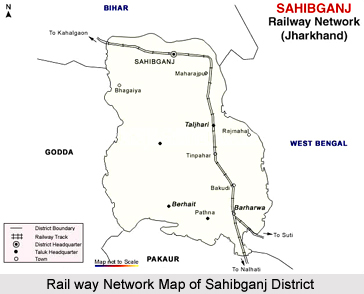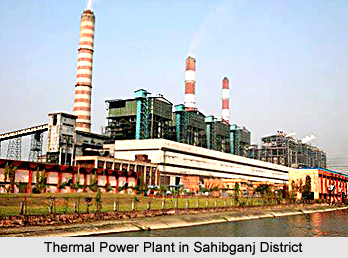 Sahibganj District in Jharkhand with a predominantly tribal population is a part of Santhal Pargana division and forms the eastern most tip of the division. This administrative district of Jharkhand has its headquarters at Sahibganj. Rajmahal District and Pakur District subdivisions of old Santhal Pargana district were carved out on 17th of May, 1983 to form Sahibganj District. Subsequently, Pakur sub-division of Sahibganj District was carved out on 28th January, 1994 to constitute Pakur District. Administration of Sahibganj District has two sub-divisions and nine administrative blocks and these are Sahibganj, Mandro, Borio, Barhait, Taljhari, Rajmahal, Udhwa, Pathna and Barharwa. The total number of villages in Sahibganj District is 1819. Of these, 1307 are inhabited and 512 uninhabited. There are 166 Village Panchayats.
Sahibganj District in Jharkhand with a predominantly tribal population is a part of Santhal Pargana division and forms the eastern most tip of the division. This administrative district of Jharkhand has its headquarters at Sahibganj. Rajmahal District and Pakur District subdivisions of old Santhal Pargana district were carved out on 17th of May, 1983 to form Sahibganj District. Subsequently, Pakur sub-division of Sahibganj District was carved out on 28th January, 1994 to constitute Pakur District. Administration of Sahibganj District has two sub-divisions and nine administrative blocks and these are Sahibganj, Mandro, Borio, Barhait, Taljhari, Rajmahal, Udhwa, Pathna and Barharwa. The total number of villages in Sahibganj District is 1819. Of these, 1307 are inhabited and 512 uninhabited. There are 166 Village Panchayats.
Location of Sahibganj District
Sahibganj District lies approximately between 24 degree 42 minutes north and 25 degree 21 minutes north latitude and between 87 degree 25 minutes and 87 degree 54 minutes east longitude. Sahibganj, the administrative headquarter of the district is situated on the bank of Ganga River at 25 degree 15 minutes north latitude and 87 degree 38 minutes east longitude. The geographical area of the district is 1599 sq km. Sahibganj District is bounded by river Ganga and Katihar District in its north, by Godda District in its south, by Malda District and Murshidabad District of West Bengal in the east, and by Bhagalpur District and Godda district in the west.
History of Sahibganj District
 Sahibganj District was formed on 17th of May, 1983 by dividing Rajmahal and Pakur sub-divisions of former Santhal Parganas district. As per historical accounts, Pakur sub-division was further bifurcated on 28th of January, 1994 to create the district of Pakur. Rajmahal sub-division of the province of Sahibganj was declared as the capital of Bengal Subah in the year 1592 by Raja Man Singh. History of this region is inter-connected with the histories of Godda District, Dumka District, Deoghar District and Pakur district.
Sahibganj District was formed on 17th of May, 1983 by dividing Rajmahal and Pakur sub-divisions of former Santhal Parganas district. As per historical accounts, Pakur sub-division was further bifurcated on 28th of January, 1994 to create the district of Pakur. Rajmahal sub-division of the province of Sahibganj was declared as the capital of Bengal Subah in the year 1592 by Raja Man Singh. History of this region is inter-connected with the histories of Godda District, Dumka District, Deoghar District and Pakur district.
Geography of Sahibganj District
Geography of Sahibganj District is spread across lush green region. A large part of the district is hilly. The region on the bank of the Ganges is fertile and cultivable. Ganga River forming the northern boundary of the district enters at its north western corner and goes eastward up to Sakrigali where it takes a turn to the south and forms the southern boundary of the district. The river has been drifting gradually to the north and Sahibganj town, which was once on the river bank, is now around a mile away. The average width of the Ganges in the district is about 4 and half kilometers.
Demography of Sahibganj District
According to the Population Census in the year 2011, Sahibganj District had a population of 1,150,038 of which male and female were 590,390 and 559,648 respectively. The population of Sahibganj District constituted 3.49 percent of total population of the Sahibganj District.
The population density of Sahibganj district is 719 people per sq. km. Sahibganj district administers 1,601 square kilometers of areas. The average literacy rate of Sahibganj District in 2011 was 53.73 percent. If things are looked out at gender wise, male and female literacy were 62.65 and 44.31 respectively. The total literates in Sahibganj District were 501,643 of which male and female were 300,522 and 201,146 respectively.
Tourism in Sahibganj District
There are several places of religious, historical and archaeological importance in Sahibganj District. Like for instance, Rajmahal Hills, Mangalhat, Kanhaiyasthan, Sahibganj, Teliagarhi, Shivgadi, Binduvasini Temple, Shukravasini Temple, Raksisthan, Bhoganadih and Panchkathiya, Udhwa Bird Sanctuary, Moti Jharna and Maghi Mela are some of the major attractions of Sahibganj District.
Sahibganj District receives most of the power supply from the Super Thermal Power Station at Kahalgaon. The extensive bed of the Ganges at Sahibganj and Rajmahal offers one of the best fields in the state for collection of fish spawn and fishing.






